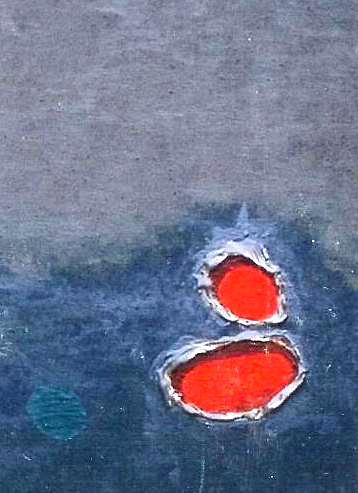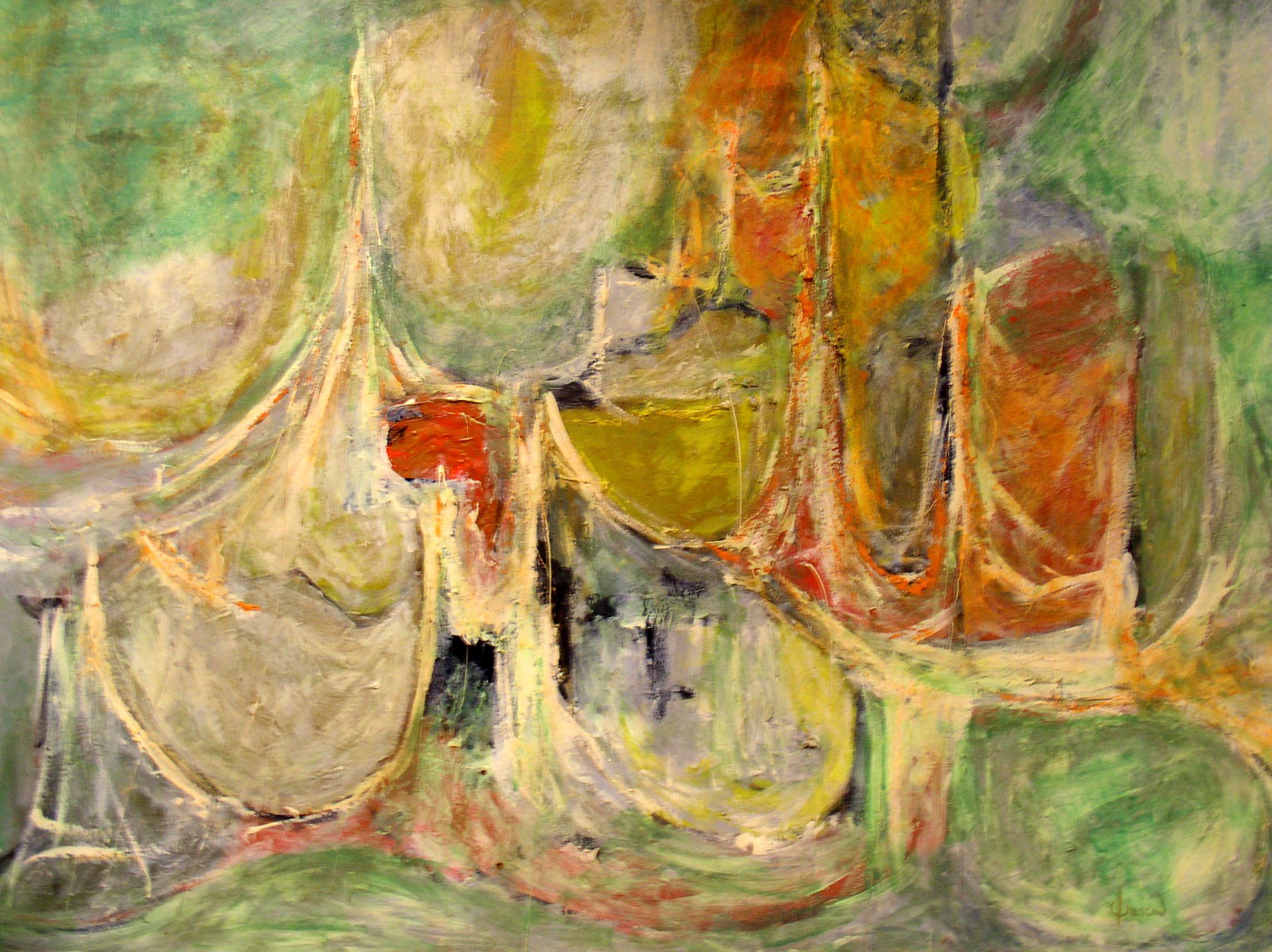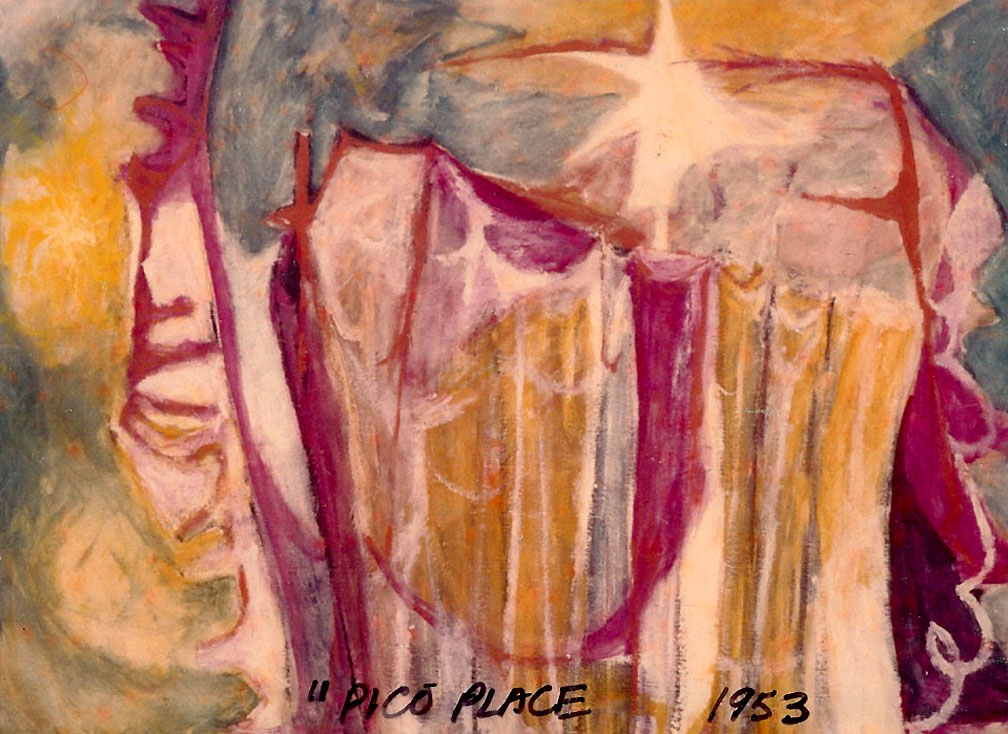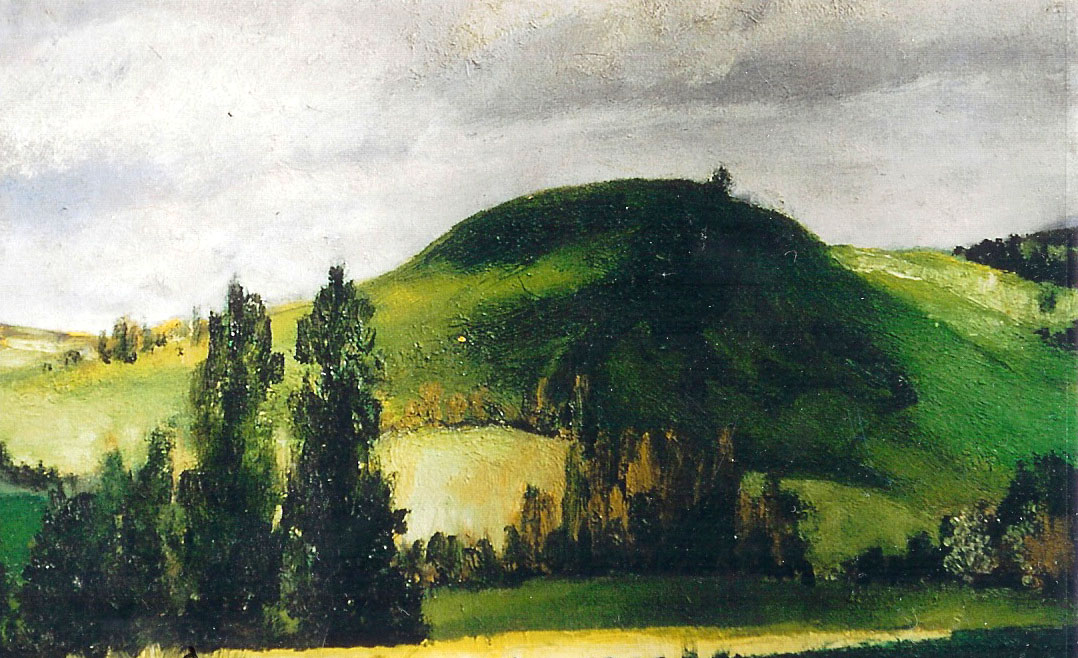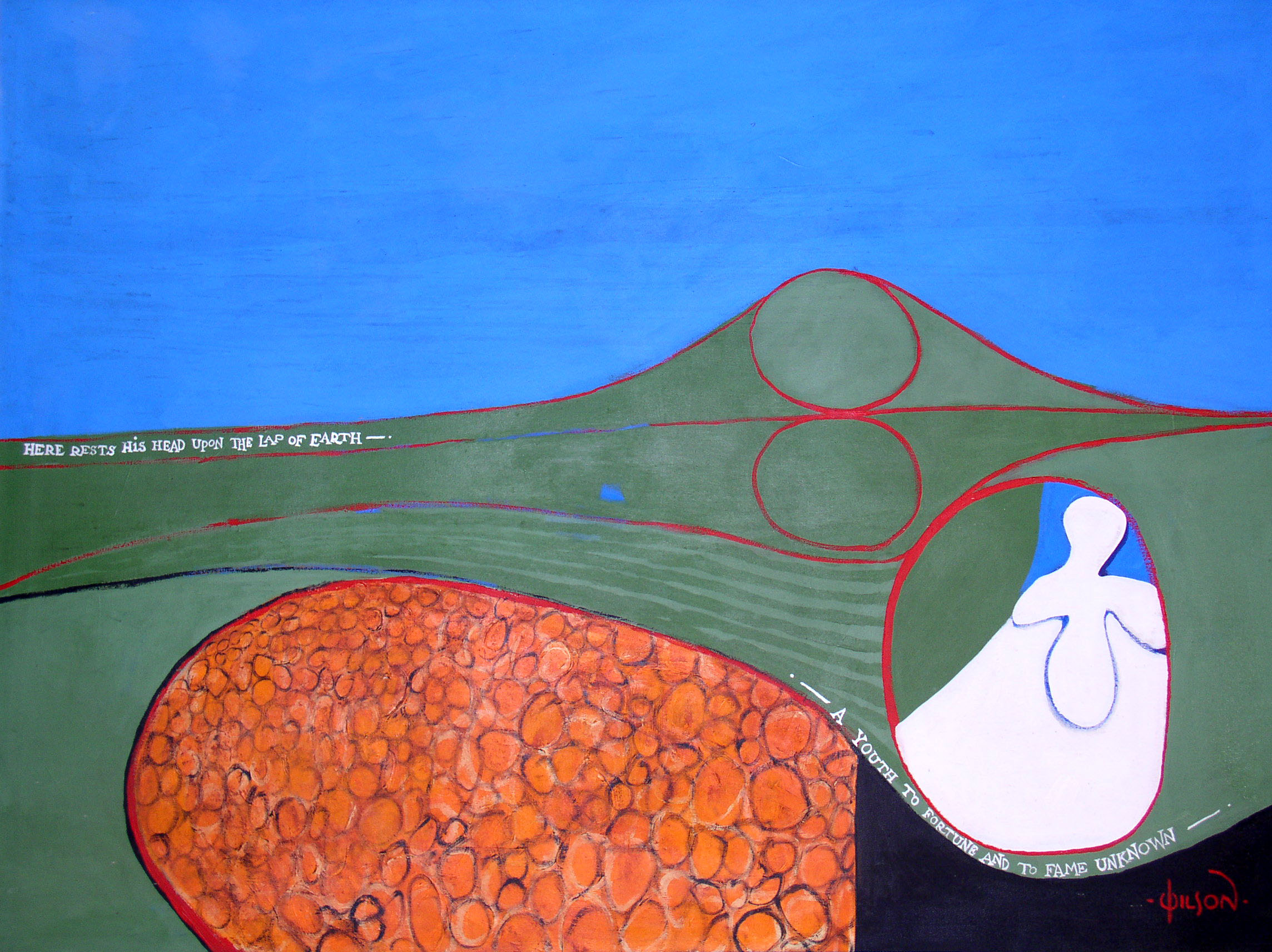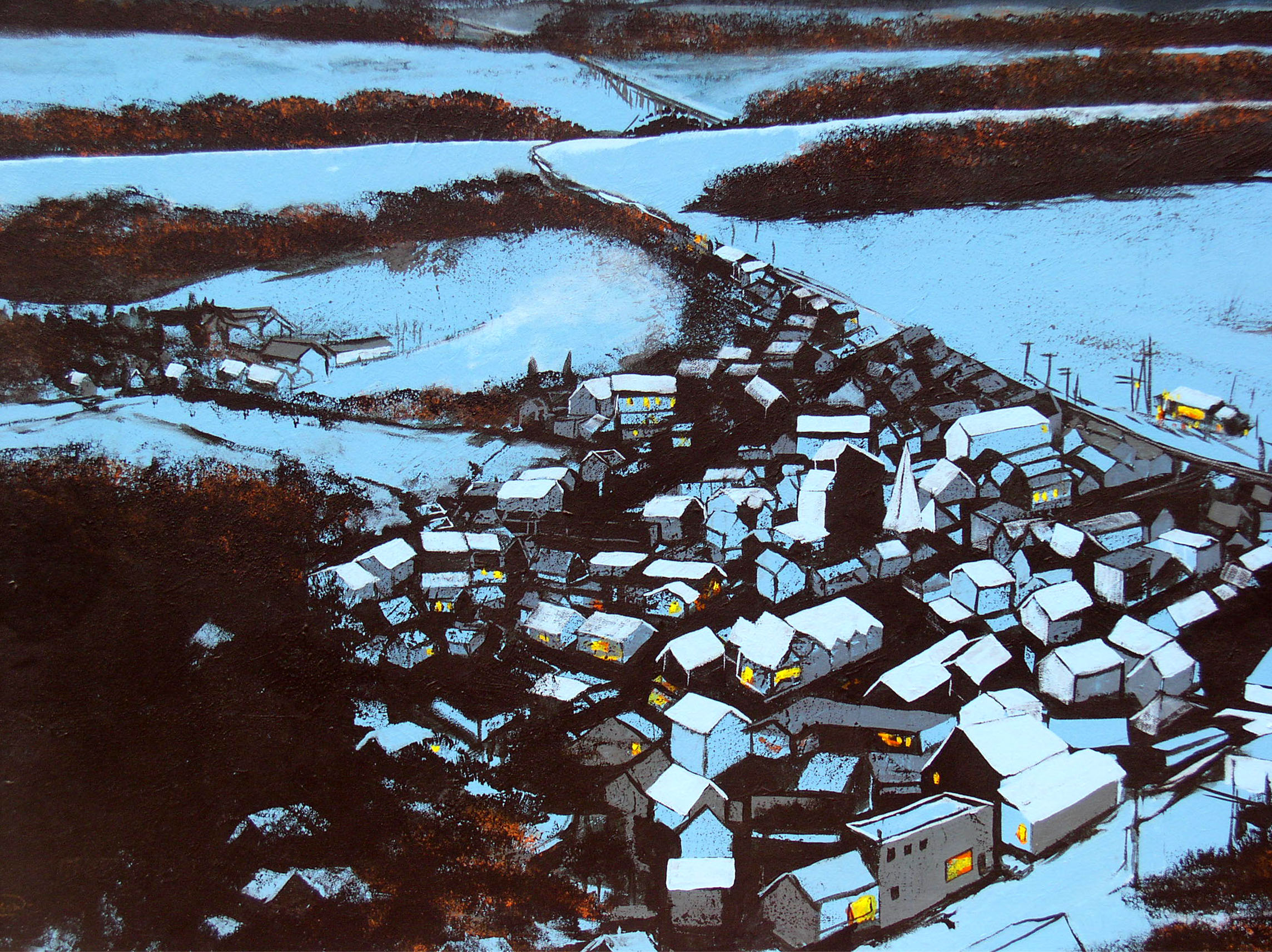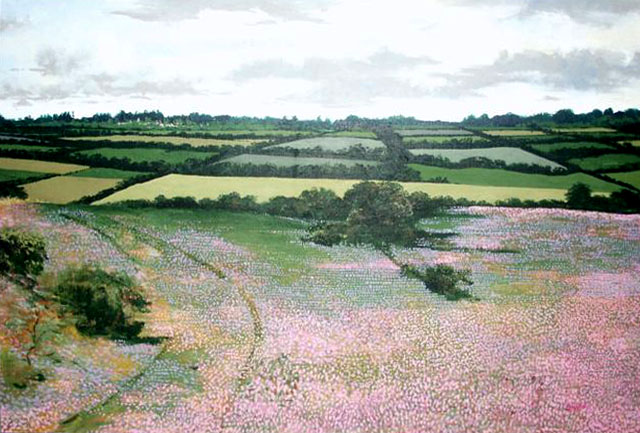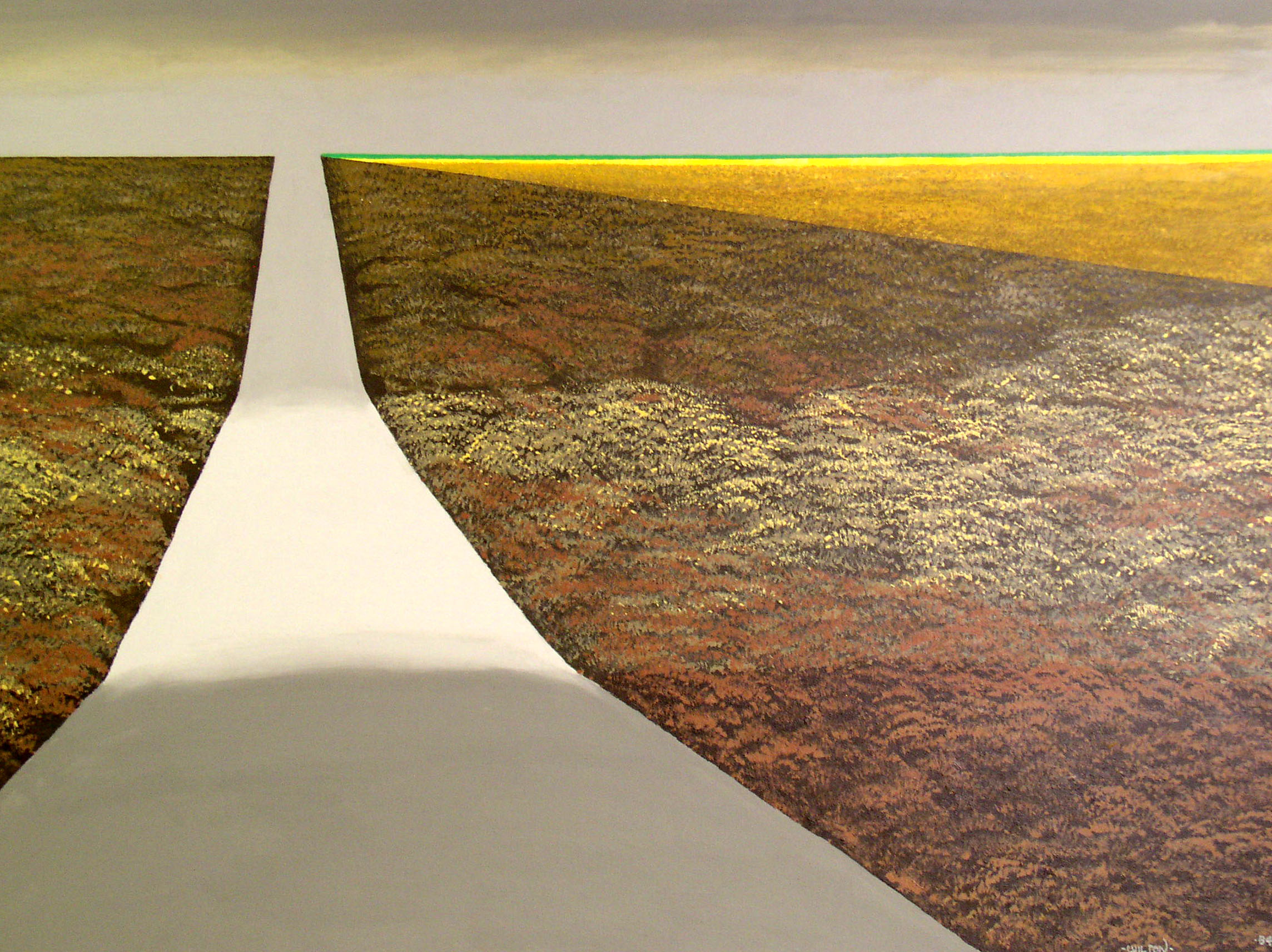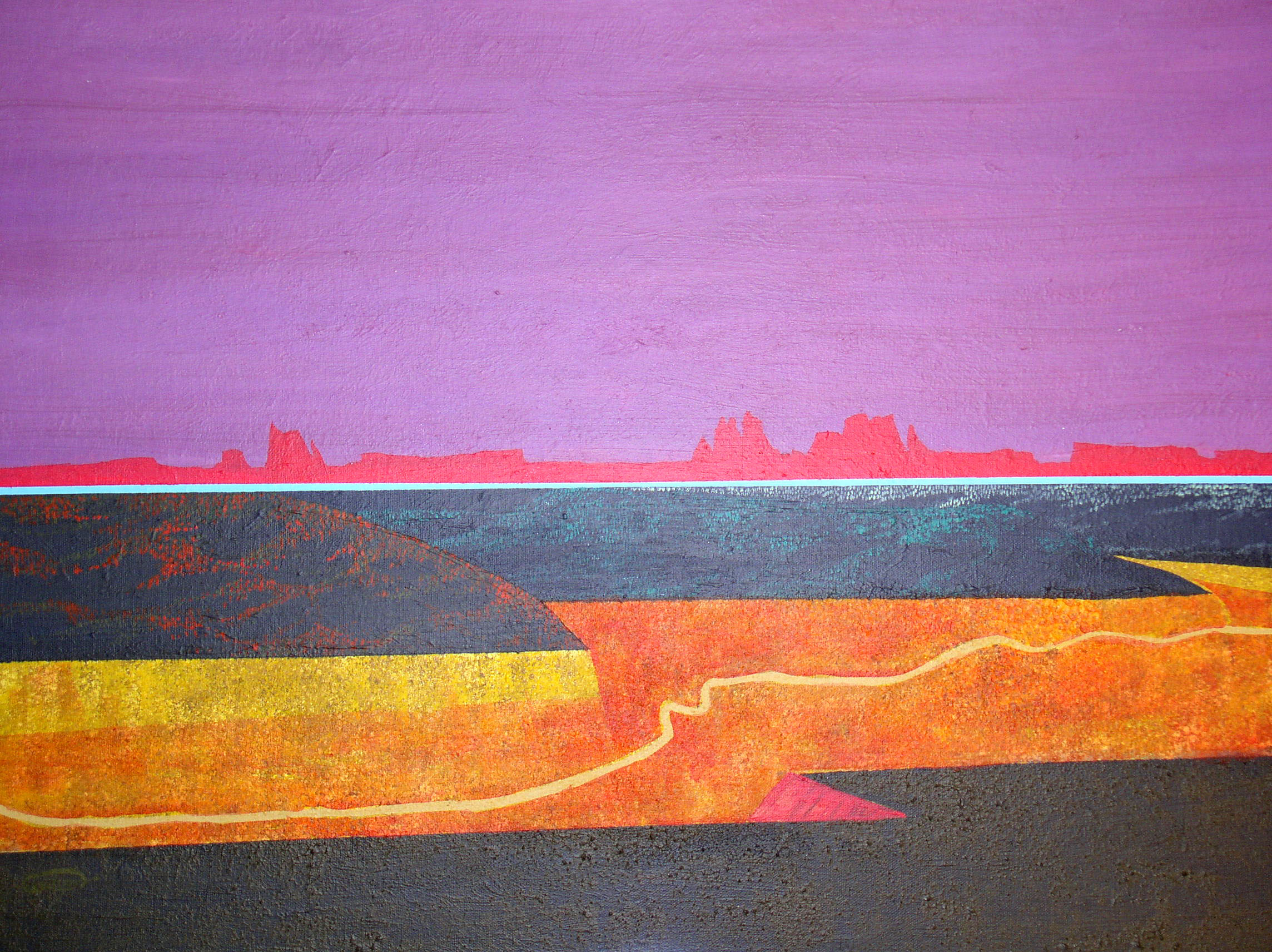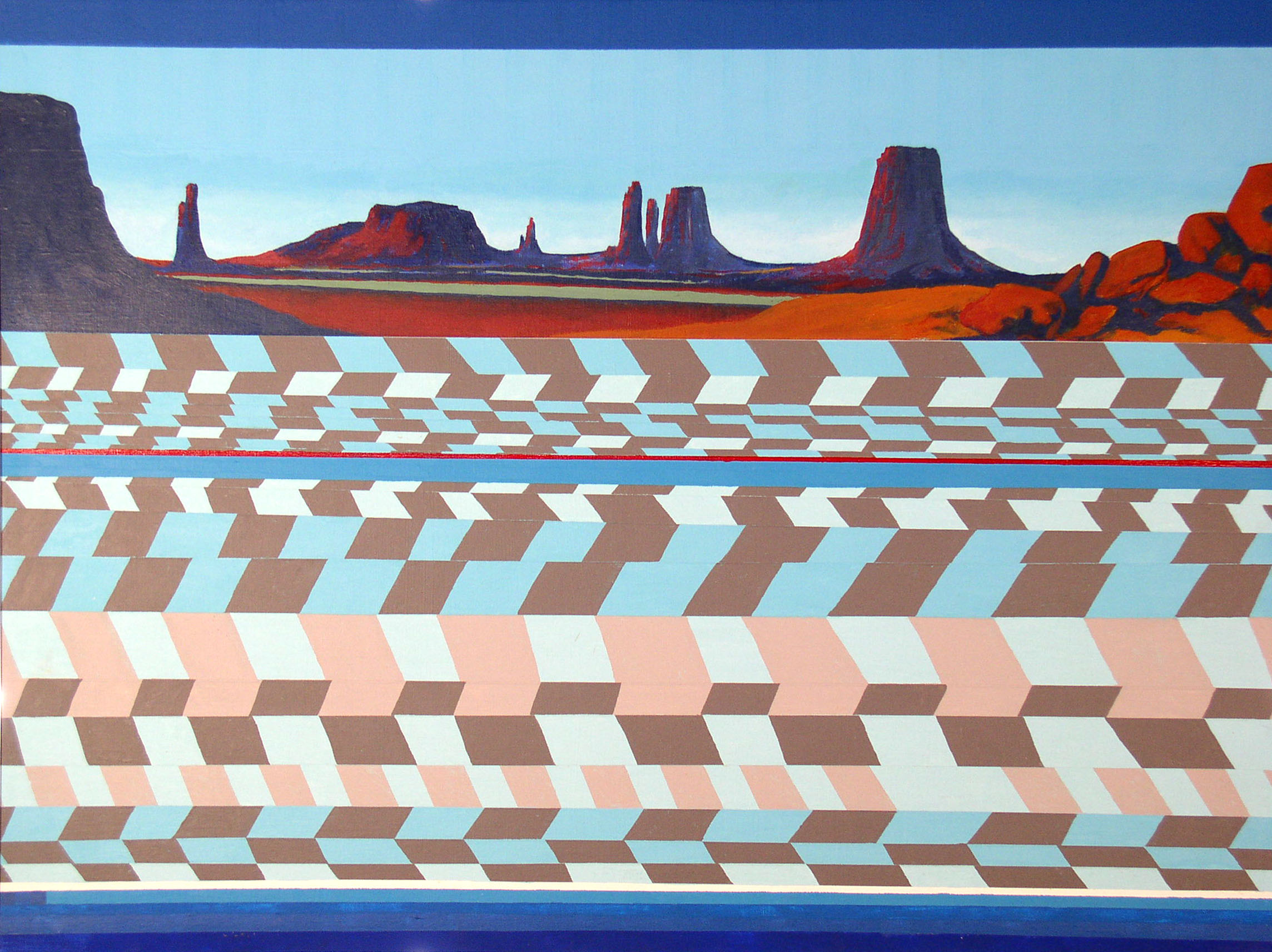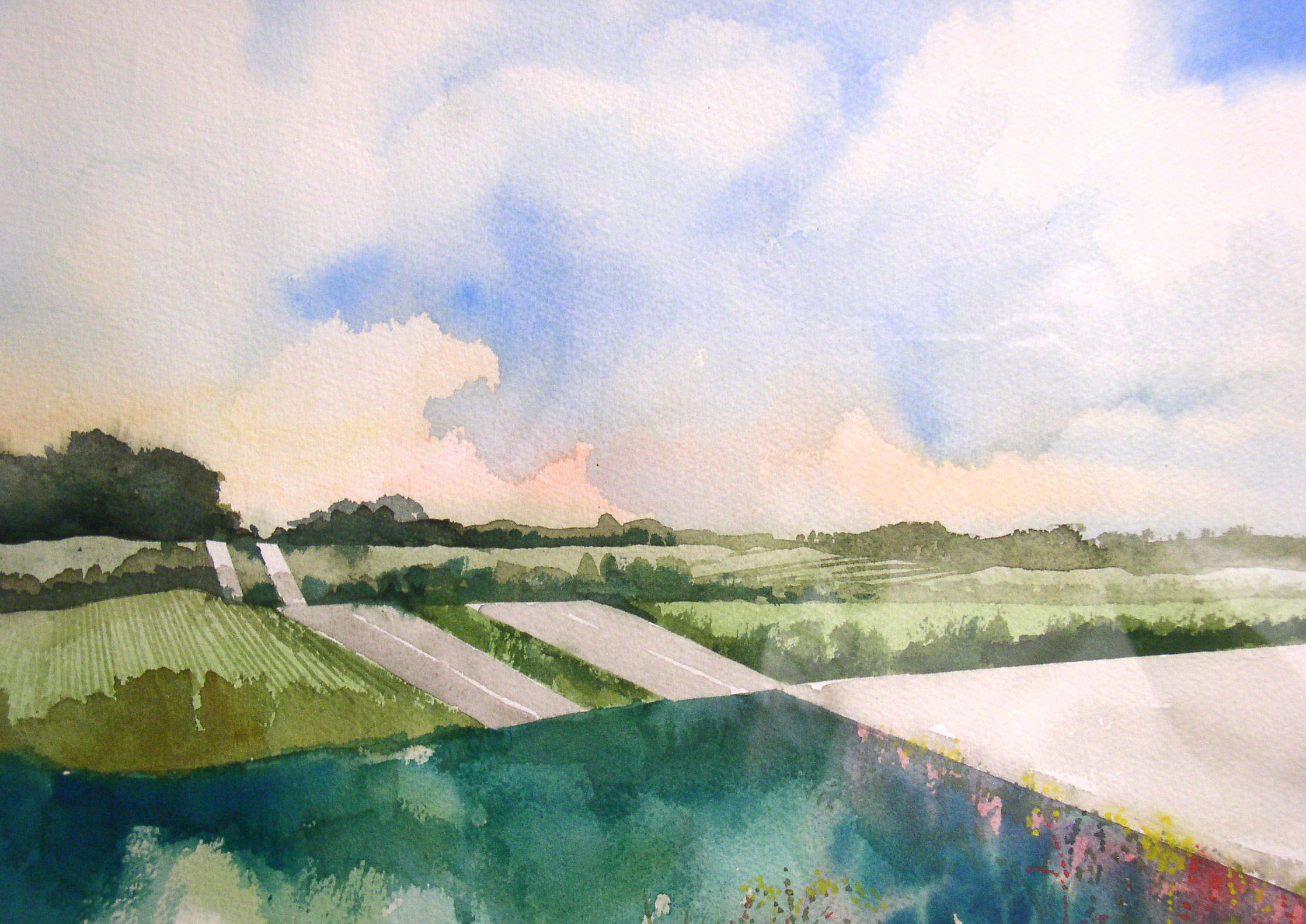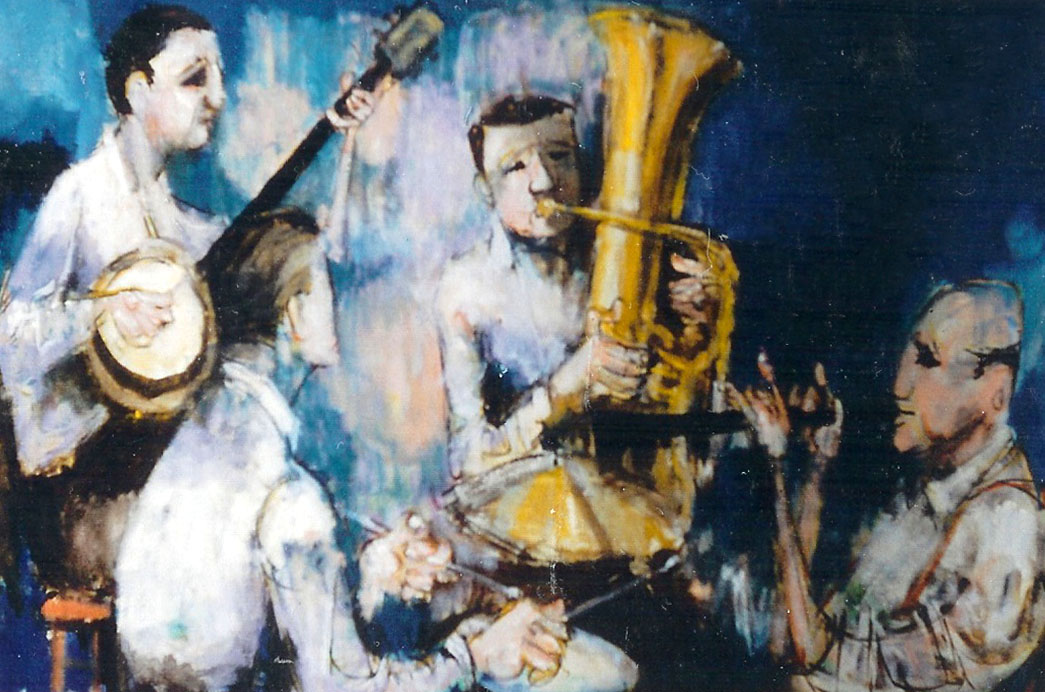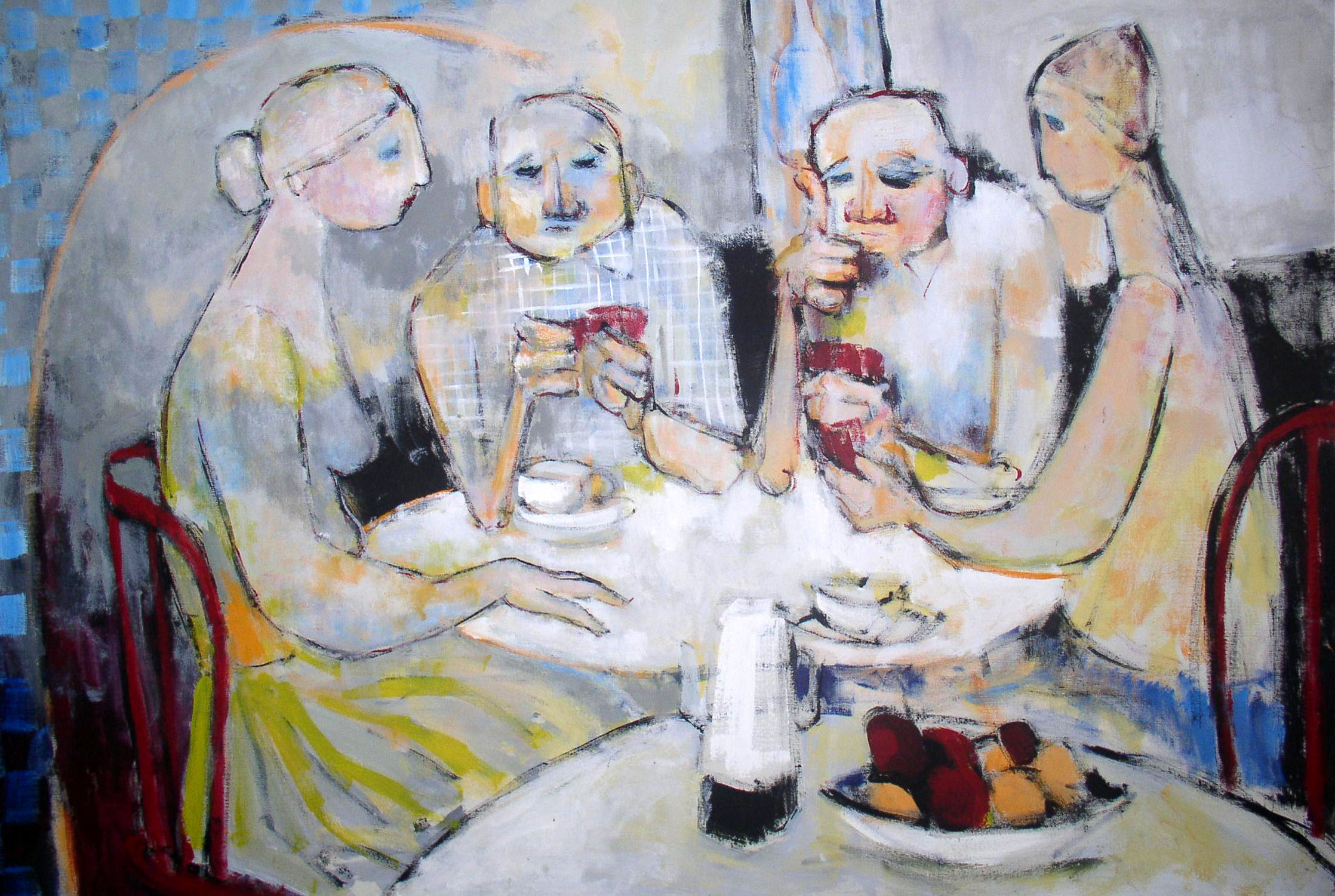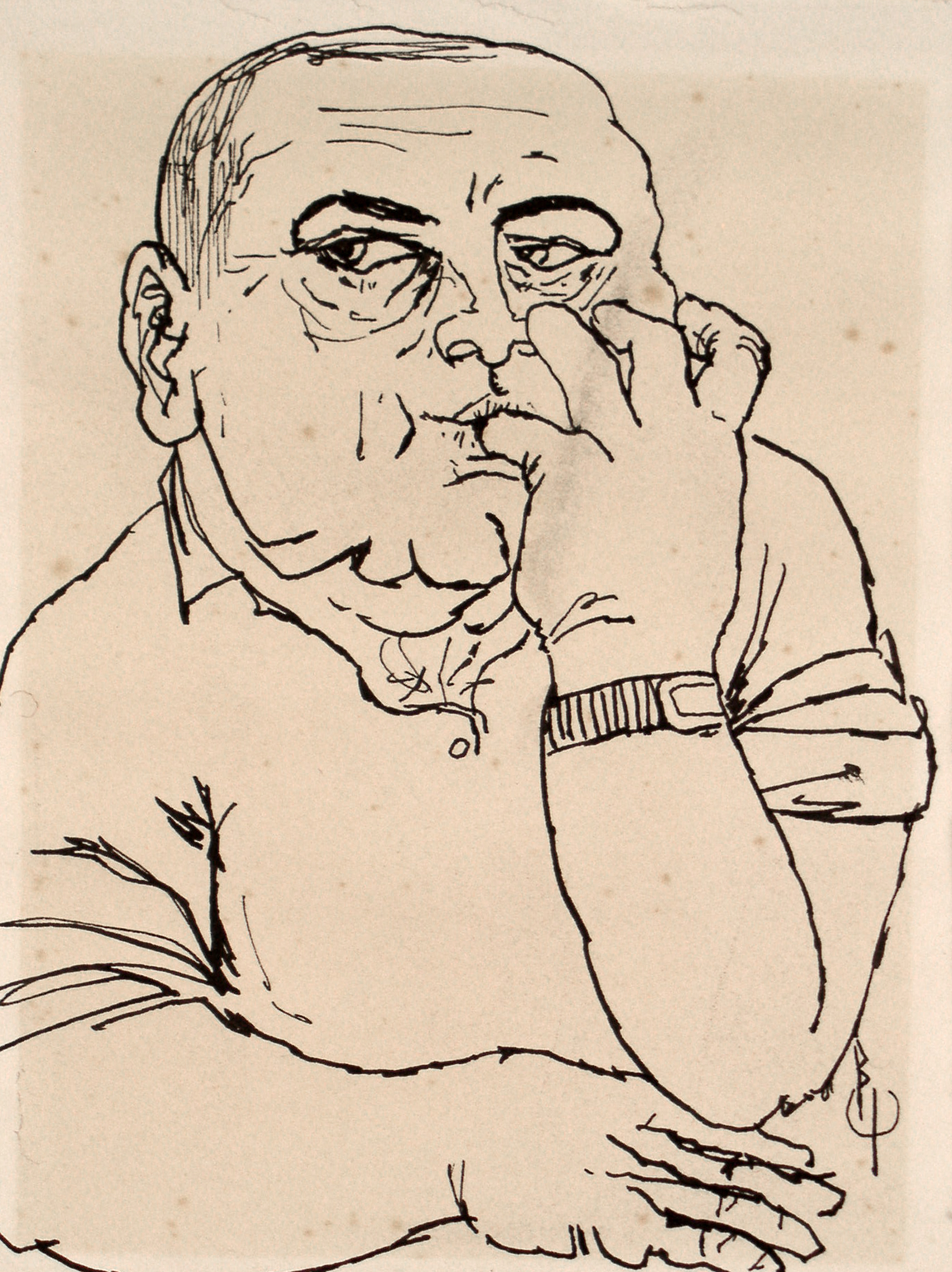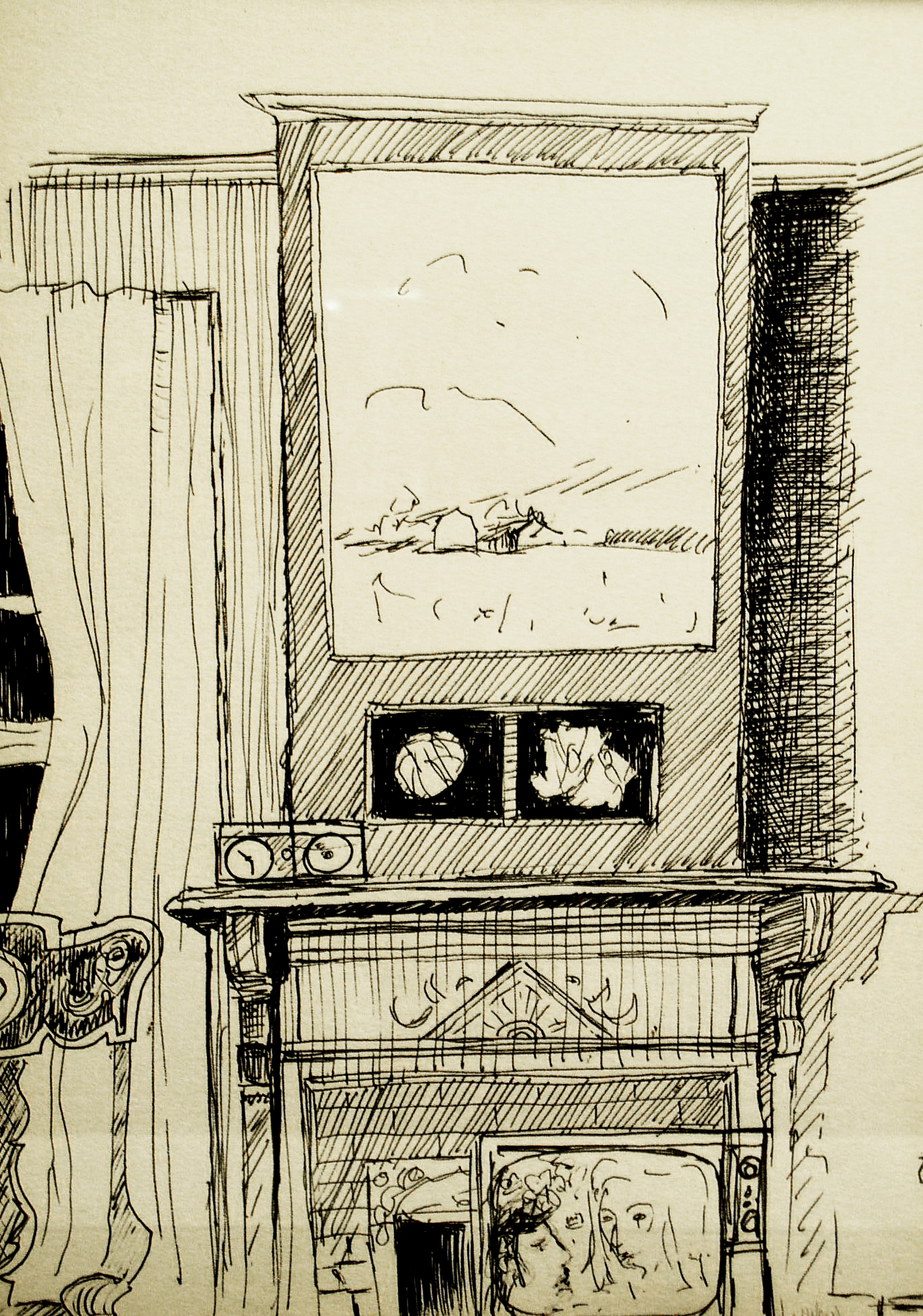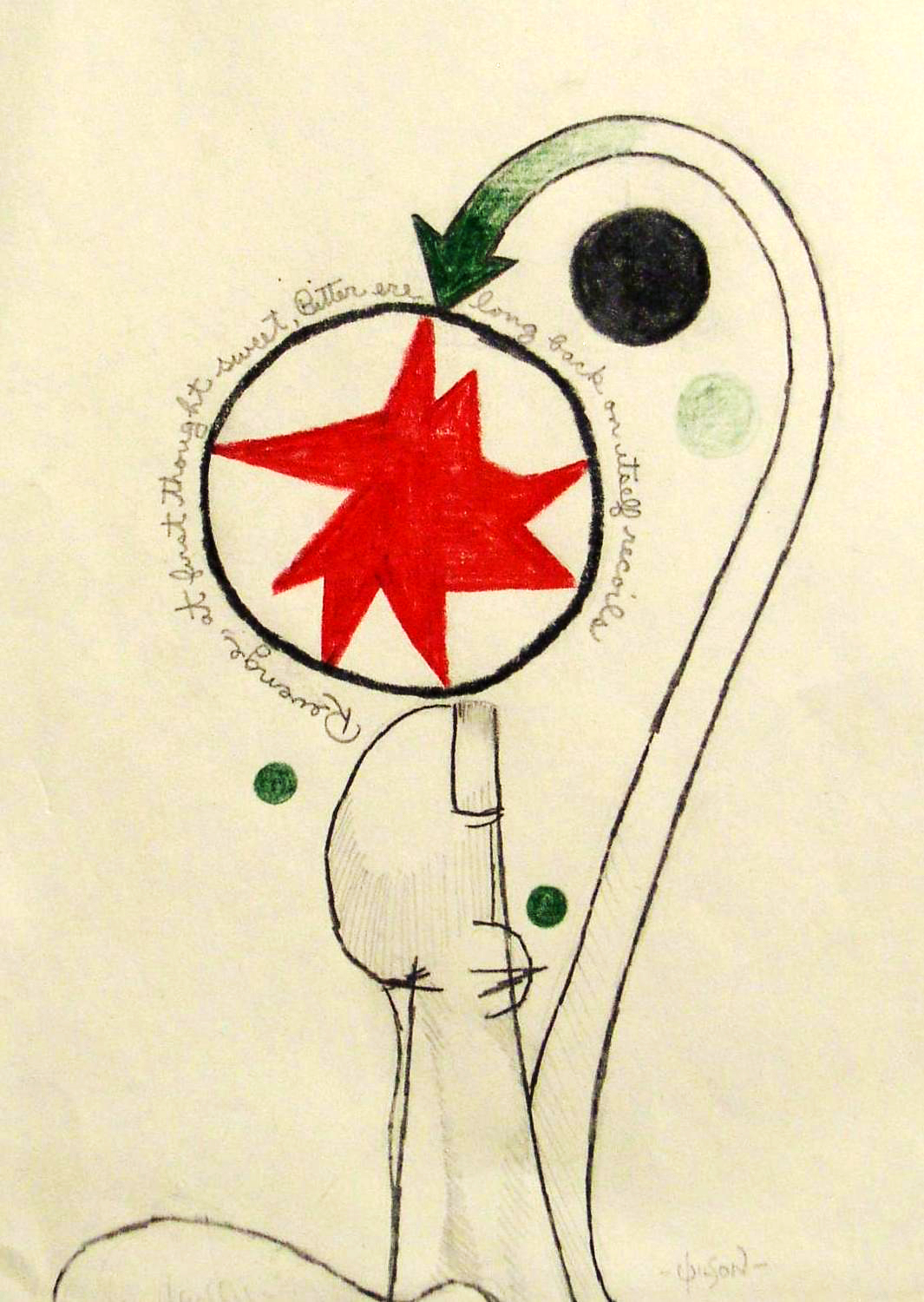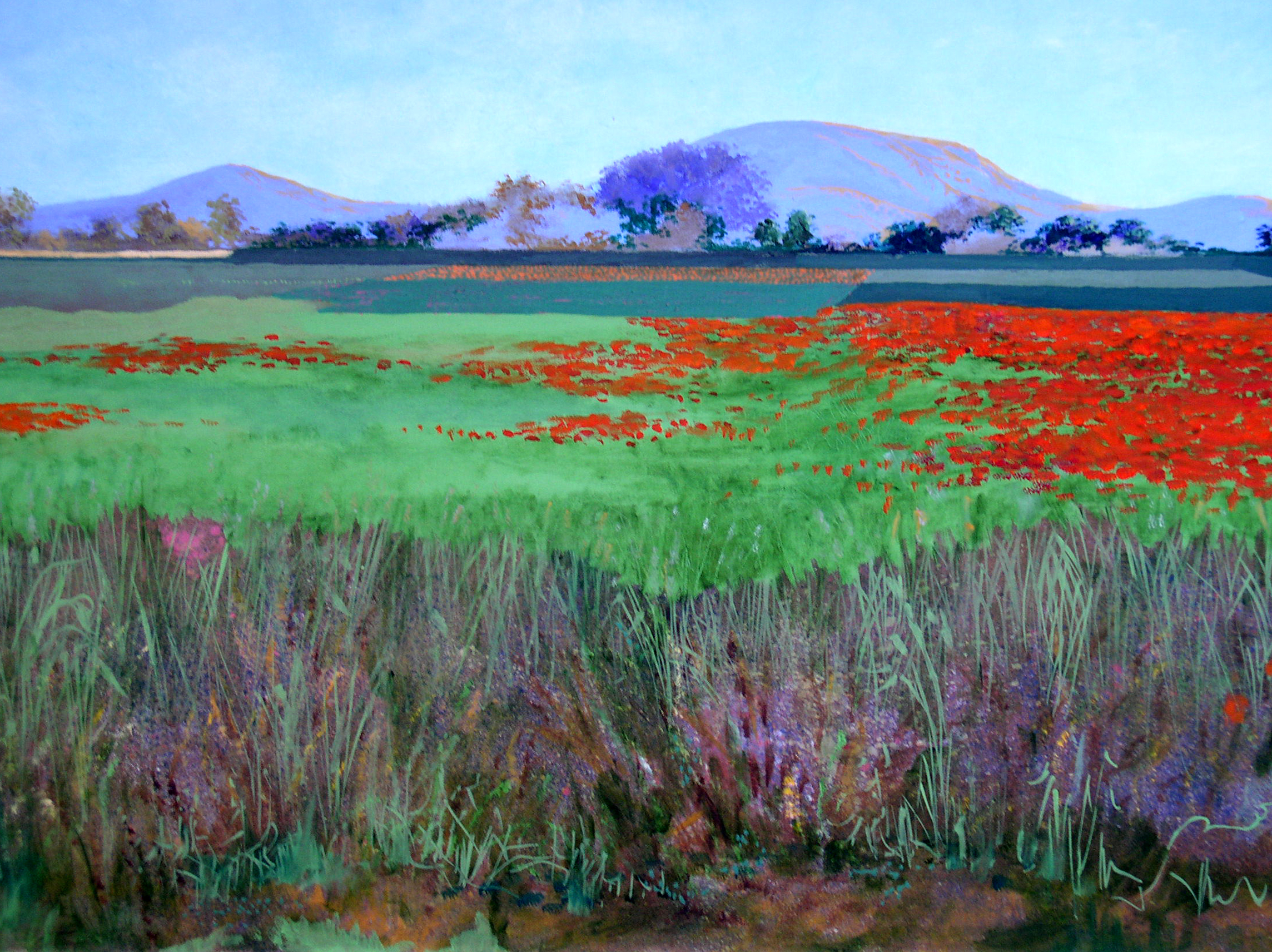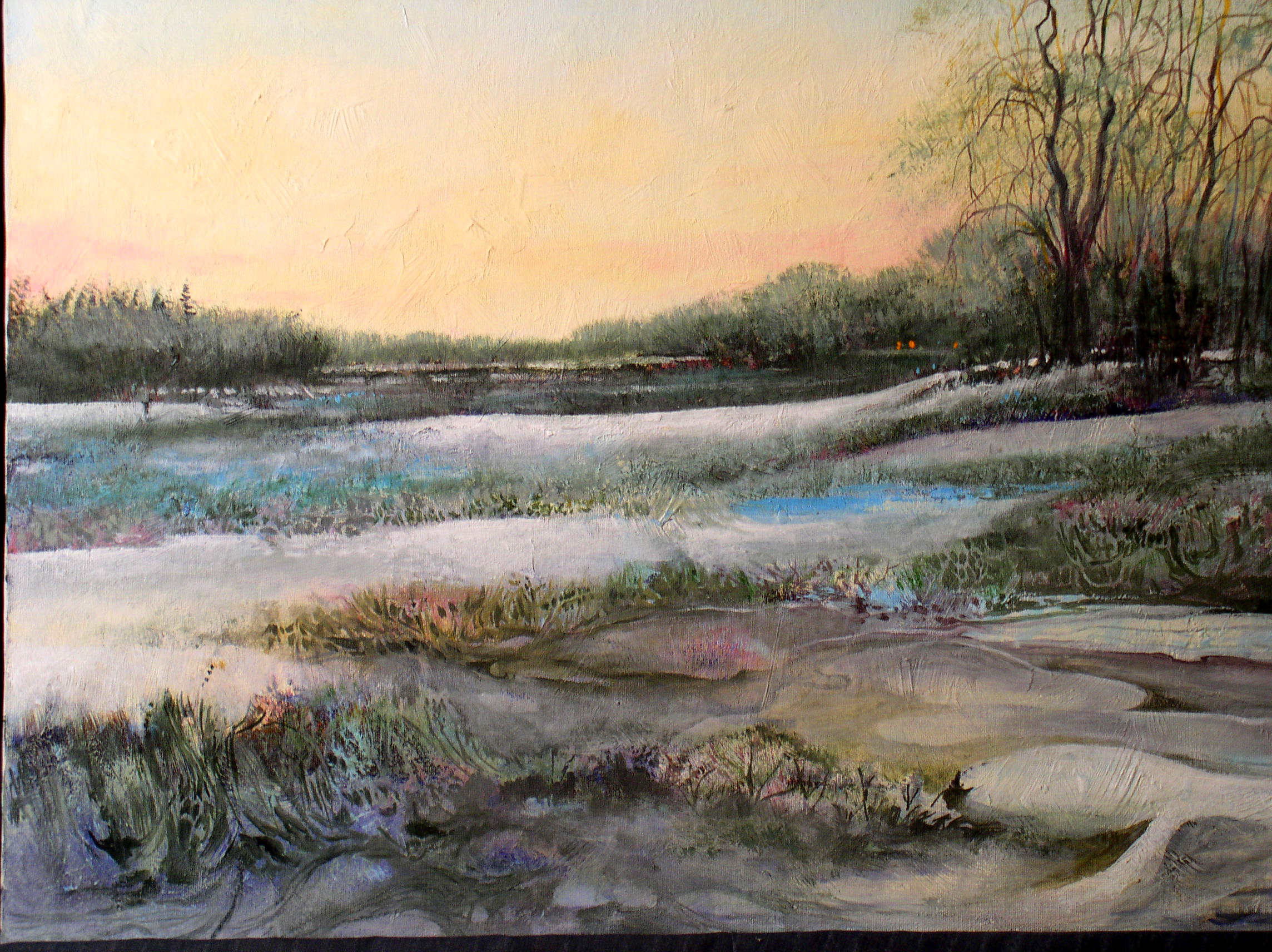

• Returning to California from the war in 1947, Robert found himself immersed in the emerging Abstract Expressionist Movement. He experimented with acrylic paint, a newly emerging media, mixed media such as burlap, paper and wood. He also combined textural additives such as sand, pencil shavings or coffee grounds to his paint for new textures.
He created large scale canvases of biomorphic shapes and arbitrary colors that referenced the places where he lived and the unique experience of Southern California. To create unusual patterns in his work, he developed a style of spraying paint through plastic, metal screens and die-cut papers to create texture.
To create depth he often cut through the canvas to reveal another layer or added a second layer on top of the canvas. These works often represent a concept of place rather than a specific geographic area.
 • As his abstract work progressed, a more stylized pattern of amorphic shapes emerged, suspended within upward curving lines. Most of these works are titled to reflect places where he lived and important life events. In later works, he began to incorporate what would become a recurring theme in his work. He incorporated specific lines of text from the works of William Butler Yeats as an element of line.
• As his abstract work progressed, a more stylized pattern of amorphic shapes emerged, suspended within upward curving lines. Most of these works are titled to reflect places where he lived and important life events. In later works, he began to incorporate what would become a recurring theme in his work. He incorporated specific lines of text from the works of William Butler Yeats as an element of line.
• At this time, early representative landscapes of his surroundings area begin to emerge within his works. Inklings of what would become his singular viewpoint begin to take shape; curving forms become hills, patches of color formed grass and earth, linear patterns become limbs and branches, brush print dabs as foliage, light and color define clouds and sky and the recurring theme of the road emerges.
 • In the early 60’s his abstract landscapes developed into a more stylized pattern of oval shapes, curving lines, layers of of flat arbitrary color and abstract textural patterns. He continued to incorporate mixed materials and poetic text as lines in the work.
• In the early 60’s his abstract landscapes developed into a more stylized pattern of oval shapes, curving lines, layers of of flat arbitrary color and abstract textural patterns. He continued to incorporate mixed materials and poetic text as lines in the work.
 • During this time Robert was teaching as well as painting. His work was shown extensively in local, state and national exhibits as well as being represented by several galleries in the Los Angeles area. This is where his mature concept of landscape painting began to take form. Curvilinear lines, shallow freeform shapes and flat arbitrary colors become softened and mottled. Intricately detailed lines and brush dabs of color created abstracted leaf and foliage textures that diminished in size as they recede in the background. Different seasons, weather patterns, and time of day were as important as the landscape he was emulating. Unusual vast viewpoints, intense color, and sharp contrasts of light and dark contribute to an exaggerated level of realism that speaks to a dream-like moment of time and place within his work.
• During this time Robert was teaching as well as painting. His work was shown extensively in local, state and national exhibits as well as being represented by several galleries in the Los Angeles area. This is where his mature concept of landscape painting began to take form. Curvilinear lines, shallow freeform shapes and flat arbitrary colors become softened and mottled. Intricately detailed lines and brush dabs of color created abstracted leaf and foliage textures that diminished in size as they recede in the background. Different seasons, weather patterns, and time of day were as important as the landscape he was emulating. Unusual vast viewpoints, intense color, and sharp contrasts of light and dark contribute to an exaggerated level of realism that speaks to a dream-like moment of time and place within his work.

• Along with these recurring elements and painting devices, certain repetitive imagery can be found throughout his body of landscape work. Among these are vast expanses of negative and ambiguous space: a horizontal line of color that represents a distant plane of illuminated land or water, a curving or refracted roadway, a circle in abstract works and the moon or sun in landscapes.
 • At certain times, he produced small series of abstract landscape works that picked up where the very early mixed–media landscapes of the late 60’s ended. This is especially true of a series of works inspired by visits to Utah, Monument Valley and The Grand Canyon. He combined iconic landscape imagery with pure non-objective elements.
• At certain times, he produced small series of abstract landscape works that picked up where the very early mixed–media landscapes of the late 60’s ended. This is especially true of a series of works inspired by visits to Utah, Monument Valley and The Grand Canyon. He combined iconic landscape imagery with pure non-objective elements.
• Throughout the 1980’s, panoramic viewpoints dominated his interest. He achieved this by painting one expanded view on 3 or 4 separate canvases which could be arranged in a row across one entire wall. It was also during this time, in the late 80's when he produced his largest landscape works.

• In terms of media, painting dominated the vast body of his work. However, drawing and watercolor works are prevalent throughout all of the periods of his artistic career and incorporate similar style characteristics techniques and thematic references.

• While he was primarily known for his landscape works, his whimsical figurative drawings and paintings were prevalent throughout the major periods of his life work. Early paintings of the figure reflect his characteristic cartoon-like style depicting people engaged in some of his favorite pastimes–music, playing cards, games and people engaged in everyday situations. Portraits of family and close friends as well as self-portraits are frequently represented throughout his career.
• Reminiscent of the contemporary artist, Ben Shahn, his early line drawings, both figurative and abstract, were primarily concerned with the use of strong expressive lines using pen and ink, line and wash, felt tip pens and markers and mixed media. 
Mature Style–1990-1996
The biggest change in the 1990’s was a switch from the use of acrylic paint to water miscible oil colors. The ability to extend the drying time of the paint allowed for a more complex depth of form and an ability to execute more intricate detail. You can also see him returning to subjects and places that he had explored in the past and returning to previous works that he felt were not quite resolved.
• During the last decade of his life, he felt the need to find one last region that his work had not covered. In 1994, he set up a home and studio in Gulfport, Mississippi. He began painting the rural and coastal landscapes of the Gulf Coast region. Upon his death in 1996, the majority of these works were donated to the Gulfport Library. They were destroyed by Hurricane Katrina in 2005.
 • Robert’s work is the visual story of the places that he called home. Through his work one can sense his keen eye on the natural world around him and his attention to the forces of nature. In looking at his complete body of work one can trace the evolutions of his thoughts and ideas. He died in Gulfport, Mississippi on October 9, 1996 and is buried in the Biloxi National Cemetery.
• Robert’s work is the visual story of the places that he called home. Through his work one can sense his keen eye on the natural world around him and his attention to the forces of nature. In looking at his complete body of work one can trace the evolutions of his thoughts and ideas. He died in Gulfport, Mississippi on October 9, 1996 and is buried in the Biloxi National Cemetery.



 • As his abstract work progressed, a more stylized pattern of amorphic shapes emerged, suspended within upward curving lines. Most of these works are titled to reflect places where he lived and important life events. In later works, he began to incorporate what would become a recurring theme in his work. He incorporated specific lines of text from the works of William Butler Yeats as an element of line.
• As his abstract work progressed, a more stylized pattern of amorphic shapes emerged, suspended within upward curving lines. Most of these works are titled to reflect places where he lived and important life events. In later works, he began to incorporate what would become a recurring theme in his work. He incorporated specific lines of text from the works of William Butler Yeats as an element of line.  • In the early 60’s his abstract landscapes developed into a more stylized pattern of oval shapes, curving lines, layers of of flat arbitrary color and abstract textural patterns. He continued to incorporate mixed materials and poetic text as lines in the work.
• In the early 60’s his abstract landscapes developed into a more stylized pattern of oval shapes, curving lines, layers of of flat arbitrary color and abstract textural patterns. He continued to incorporate mixed materials and poetic text as lines in the work. • During this time Robert was teaching as well as painting. His work was shown extensively in local, state and national exhibits as well as being represented by several galleries in the Los Angeles area. This is where his mature concept of landscape painting began to take form. Curvilinear lines, shallow freeform shapes and flat arbitrary colors become softened and mottled. Intricately detailed lines and brush dabs of color created abstracted leaf and foliage textures that diminished in size as they recede in the background. Different seasons, weather patterns, and time of day were as important as the landscape he was emulating. Unusual vast viewpoints, intense color, and sharp contrasts of light and dark contribute to an exaggerated level of realism that speaks to a dream-like moment of time and place within his work.
• During this time Robert was teaching as well as painting. His work was shown extensively in local, state and national exhibits as well as being represented by several galleries in the Los Angeles area. This is where his mature concept of landscape painting began to take form. Curvilinear lines, shallow freeform shapes and flat arbitrary colors become softened and mottled. Intricately detailed lines and brush dabs of color created abstracted leaf and foliage textures that diminished in size as they recede in the background. Different seasons, weather patterns, and time of day were as important as the landscape he was emulating. Unusual vast viewpoints, intense color, and sharp contrasts of light and dark contribute to an exaggerated level of realism that speaks to a dream-like moment of time and place within his work.
 • At certain times, he produced small series of abstract landscape works that picked up where the very early mixed–media landscapes of the late 60’s ended. This is especially true of a series of works inspired by visits to Utah, Monument Valley and The Grand Canyon. He combined iconic landscape imagery with pure non-objective elements.
• At certain times, he produced small series of abstract landscape works that picked up where the very early mixed–media landscapes of the late 60’s ended. This is especially true of a series of works inspired by visits to Utah, Monument Valley and The Grand Canyon. He combined iconic landscape imagery with pure non-objective elements. 


 • Robert’s work is the visual story of the places that he called home. Through his work one can sense his keen eye on the natural world around him and his attention to the forces of nature. In looking at his complete body of work one can trace the evolutions of his thoughts and ideas. He died in Gulfport, Mississippi on October 9, 1996 and is buried in the Biloxi National Cemetery.
• Robert’s work is the visual story of the places that he called home. Through his work one can sense his keen eye on the natural world around him and his attention to the forces of nature. In looking at his complete body of work one can trace the evolutions of his thoughts and ideas. He died in Gulfport, Mississippi on October 9, 1996 and is buried in the Biloxi National Cemetery. 